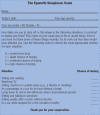The assessment, diagnosis, and treatment of excessive sleepiness: practical considerations for the psychiatrist
- PMID: 20532118
- PMCID: PMC2880940
The assessment, diagnosis, and treatment of excessive sleepiness: practical considerations for the psychiatrist
Abstract
Excessive sleepiness occurs frequently in the general population and is a common feature of many psychiatric conditions. The reductions in quality of life associated with excessive sleepiness may be substantial, involving compromised cognitive performance and work productivity as well as possible harm to the individual and the public. Excessive sleepiness may be the result of a number of extrinsic and intrinsic causes. Although it is an established symptom of certain psychiatric illnesses, abnormal excessive sleepiness in psychiatric patients may be the result of a comorbid disorder of sleep or wakefulness. Underdiagnosis and undertreatment of sleep disorders are common in community psychiatric practices because clinicians may not be aware of the different causes and consequences of excessive sleepiness. It is essential to recognize and treat the underlying cause of this disorder. In cases where sleep disorders are suspected, a comprehensive treatment program might include nonpharmacologic approaches, pharmacologic approaches, or both may need to be initiated to encompass the complexity of sleep disorder treatments. Careful monitoring and follow-up of patients with excessive daytime sleepiness, including counseling and long-term support, are essential to ensure treatment compliance and to maintain improvements over time.
Keywords: depression; excessive sleepiness; psychiatric conditions; psychotropic drugs; sleep disorders.
Figures
Similar articles
-
Recent advances in the treatment and management of excessive daytime sleepiness.CNS Spectr. 2007 Feb;12(2 Suppl 2):1-14; quiz 15. doi: 10.1017/s1092852900028376. CNS Spectr. 2007. PMID: 17277717
-
Excessive daytime sleepiness in sleep disorders.J Thorac Dis. 2012 Dec;4(6):608-16. doi: 10.3978/j.issn.2072-1439.2012.10.07. J Thorac Dis. 2012. PMID: 23205286 Free PMC article.
-
Excessive daytime sleepiness: considerations for the psychiatrist.Psychiatr Clin North Am. 2006 Dec;29(4):921-45; abstract viii. doi: 10.1016/j.psc.2006.09.004. Psychiatr Clin North Am. 2006. PMID: 17118275 Review.
-
Excessive daytime sleepiness in adolescents: current treatment strategies.Sleep Sci. 2020 Apr-Jun;13(2):157-171. doi: 10.5935/1984-0063.20190143. Sleep Sci. 2020. PMID: 32742588 Free PMC article.
-
From wakefulness to excessive sleepiness: what we know and still need to know.Sleep Med Rev. 2008 Apr;12(2):129-41. doi: 10.1016/j.smrv.2008.01.001. Sleep Med Rev. 2008. PMID: 18342261 Free PMC article. Review.
Cited by
-
Examining the impact of excessive daytime sleepiness on utility scores in patients with obstructive sleep apnoea and/or narcolepsy in five European countries.BMC Neurol. 2022 Aug 25;22(1):317. doi: 10.1186/s12883-022-02827-7. BMC Neurol. 2022. PMID: 36008792 Free PMC article.
-
Animal models of sleep disorders.Comp Med. 2013 Apr;63(2):91-104. Comp Med. 2013. PMID: 23582416 Free PMC article. Review.
-
Change in daytime sleepiness and cognitive function in a 6-month, double-blind study of lurasidone and quetiapine XR in patients with schizophrenia.Schizophr Res Cogn. 2016 Jun 2;5:7-12. doi: 10.1016/j.scog.2016.05.002. eCollection 2016 Sep. Schizophr Res Cogn. 2016. PMID: 28740811 Free PMC article.
-
The use of an online Epworth Sleepiness Scale to assess excessive daytime sleepiness.Sleep Breath. 2017 May;21(2):333-340. doi: 10.1007/s11325-016-1417-x. Epub 2016 Nov 12. Sleep Breath. 2017. PMID: 27837377 Free PMC article.
-
Quality measures for the care of adult patients with obstructive sleep apnea: 2022 update after measure maintenance.J Clin Sleep Med. 2022 Nov 1;18(11):2673-2680. doi: 10.5664/jcsm.10244. J Clin Sleep Med. 2022. PMID: 36308029 Free PMC article.
References
-
- Lee-Chiong TL. Manifestations and classifications of sleep disorders. In: Lee-Chiong TL, Sateia MJ, Carskadon MA, editors. Sleep Medicine. Philadelphia, PA: Hanley … Belfus; 2002. pp. 125–41.
-
- Wise MS. Objective measures of sleepiness and wakefulness: Application to the real world? J Clin Neurophysiol. 2006;23:39–49. - PubMed
-
- Institute of Medicine of the National Academies. Committee on Sleep Medicine and Research. In: Colten HR, Altevogt BM, editors. Sleep Disorders and Sleep Deprivation: An Unmet Public Health Problem. Washington, DC: National Academy of Sciences; 2006. - PubMed
-
- Posternak MA, Zimmerman M. Partial validation of the atypical features subtype of major depressive disorder. Arch Gen Psychiatry. 2002;59:70–6. - PubMed
-
- Horwath E, Johnson J, Weissman MM, et al. The validity of major depression with atypical features based on a community study. J Affect Disord. 1992;26:117–25. - PubMed
LinkOut - more resources
Full Text Sources

